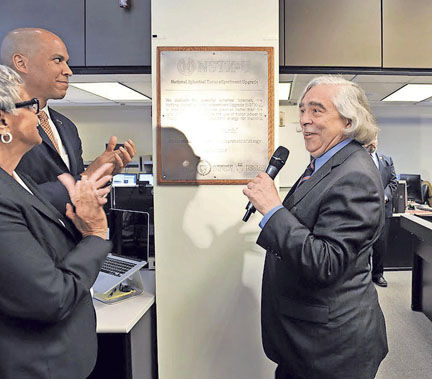By Lea Kahn, Staff Writer
PLAINSBORO — Moving one step closer toward creating the equivalent of “a star on earth,” the Princeton Plasma Physics Laboratory’s new National Spherical Torus Experiment-Upgrade was dedicated in a special ceremony Friday afternoon.
The experimental fusion energy device will produce high-performance plasmas — a super-hot gas that is the fourth state of matter — that will be hotter than the core of the sun. The aim is to explore the use of fusion power to generate electricity in a safe, clean way.
Officials, including U.S. Secretary of Energy Ernest Moniz, U.S. Senator Cory Booker, U.S. Rep. Bonnie Watson-Coleman, Plainsboro Township Mayor Peter Cantu, Princeton Mayor Liz Lempert and Princeton University President Christopher Eisgruber, were on hand for the event.
All were given a guided tour of the Princeton Plasma Physics Laboratory — and a peak at the NSTX-U — on Stellarator Road in Plainsboro Township, following some introductory remarks by Stewart Prager, the director of PPPL.
Researchers have been working hard to make fusion power a reality, Mr. Prager said. Fusion is a safe, clean and practically limitless source of energy for generating electricity — without burning fossil fuels — and will transform how energy will be produced.
Leaving the main building where Mr. Prager offered his remarks, the group walked across an asphalt lot to the building that houses the NSTX-U. Passing through corridors and up two flights of metal steps and onto a metal platform, the group found themselves eye-to-eye with the NSTX-U.
Sitting in the middle of a nearly octagonal “collar,” the NSTX-U is 23 feet tall and weighs about 85 tons. Attached to it are 12 metal arcs that contain magnets, and more than a dozen red wires that form a crown of sorts on top of it. An American flag stands above the NSTX-U.
“It may not look beautiful to you, but it is beautiful to us,” Mr. Prager said, adding that it will allow researchers to “push the frontier.” Those researchers are not limited to the scientists and engineers at PPPL. It is an international effort, involving scientists and engineers from many countries.
The U.S. Secretary of Energy, Mr. Moniz, agreed and said that “there is not going to be one solution. There may be four or five solutions.”
Following the tour, Sen. Booker told the group that he wants to focus on innovation. Other countries have outpaced the United States in innovation, the senator said, and he wants this country to become a “net exporter” of innovation.
Rep. Watson-Coleman said there is a need for clean energy, adding that “I am so happy to be here. This is so encouraging. We are going to figure this out.” She said that she wants to be part of what the scientists and engineers are doing to make the world a better place.
In the control room, which was filled with researchers working on computer screens, Secretary Moniz praised Sen. Booker and Rep. Watson-Coleman. They are two “strong supporters of innovation,” he said. He echoed Rep. Watson-Coleman’s call for more women and minorities to seek careers as scientists,
Walking over to a column in the control room, Secretary Moniz looked at the black cloth covering the soon-to-be-unveiled dedicatory plaque.
“We are here for the dedication of this facility. There is no doubt about it. This is big step for our fusion program,” Secretary Moniz said.
Then, he pulled off the black cloth to reveal the plaque dedicating the NSXT-U, “which will produce high-performance plasmas hotter than the core of the sun and explore the usage of fusion power to create clean, safe and abundant energy for mankind.”
And “a star on earth” was born.

